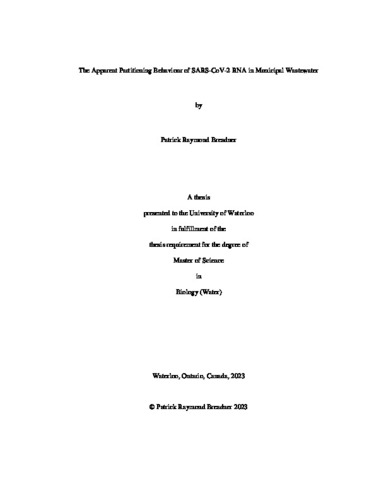| dc.contributor.author | Breadner, Patrick | |
| dc.date.accessioned | 2023-04-10 12:45:42 (GMT) | |
| dc.date.available | 2023-04-10 12:45:42 (GMT) | |
| dc.date.issued | 2023-04-10 | |
| dc.date.submitted | 2023-03-15 | |
| dc.identifier.uri | http://hdl.handle.net/10012/19258 | |
| dc.description.abstract | The use of wastewater-based surveillance (WBS) has experienced rapid expansion and development since the onset of the coronavirus disease (COVID-19) pandemic that is caused by the virus severe acute respiratory syndrome coronavirus 2 (SARS-CoV-2). WBS has become a vital resource for tracking the spread of COVID-19 across communities as fragments of SARS-CoV-2 RNA can be quantified and measured temporally in wastewater. However, the absence of standardized methods across labs and remaining methodological issues can impact the interpretation of data for public health efforts. In particular, characterizing how RNA fragments of SARS-CoV-2 partition in wastewater is a central part of understanding its fate and behaviour in the wastewater. Additionally, various laboratories analyze either the liquid or solid fraction, and this has implications for the interpretation of analytical results and trends. The partitioning of SARS-CoV-2 RNA was examined in a series of experiments that were conducted using centrifugation with varied spin time and centrifugal force, polyethylene glycol precipitation followed by centrifugation, and ultrafiltration of wastewater. Partitioning of the endogenous pepper mild mottled virus (PMMoV) was also examined as it is commonly used to normalize the SARS-CoV-2 signal for fecal load in trend analysis. Additionally, two coronavirus surrogates, human coronavirus 229E and murine hepatitis virus, were analyzed as internal process controls. Although SARS-CoV-2 has an affinity for solids, the total RNA copies of SARS-CoV-2 per wastewater sample split evenly between the liquid and solid fractions after centrifugation (i.e., 12,000 x 𝑔 for 1.5 h without a brake). A longer and faster spin resulted in a shift in partitioning for all viruses toward the solid fraction except for PMMoV which remained mostly in the liquid fraction. This observation supports that the surrogates are more reflective of SARS-CoV-2 than the endogenous reference (PMMoV). Surprisingly, ultrafiltration devices were inconsistent in estimating RNA copies in wastewater which can influence the interpretation of partitioning. Developing a better understanding of the fate of SARS-CoV-2 in wastewater and creating a foundation of best practices is key to supporting the current pandemic response but also to prepare for future potential infectious diseases. | en |
| dc.language.iso | en | en |
| dc.publisher | University of Waterloo | en |
| dc.subject | COVID-19 | en |
| dc.subject | SARS-CoV-2 | en |
| dc.subject | wastewater-based surveillance | en |
| dc.subject | viral partitioning | en |
| dc.subject | PEG precipitation | en |
| dc.subject | ultrafiltration device | en |
| dc.title | The Apparent Partitioning Behaviour of SARS-CoV-2 RNA in Municipal Wastewater | en |
| dc.type | Master Thesis | en |
| dc.pending | false | |
| uws-etd.degree.department | Biology | en |
| uws-etd.degree.discipline | Biology (Water) | en |
| uws-etd.degree.grantor | University of Waterloo | en |
| uws-etd.degree | Master of Science | en |
| uws-etd.embargo.terms | 0 | en |
| uws.contributor.advisor | Servos, Mark | |
| uws.contributor.affiliation1 | Faculty of Science | en |
| uws.published.city | Waterloo | en |
| uws.published.country | Canada | en |
| uws.published.province | Ontario | en |
| uws.typeOfResource | Text | en |
| uws.peerReviewStatus | Unreviewed | en |
| uws.scholarLevel | Graduate | en |

